
All images © by Roberto Piperno, owner of the domain. Write to romapip@quipo.it.
Notes:
Page added in September 2025.

All images © by Roberto Piperno, owner of the domain. Write to romapip@quipo.it.
Notes:
Page added in September 2025.
 Massa Marittima - The Cathedral
Massa Marittima - The CathedralYou may wish to read page one covering the town first.
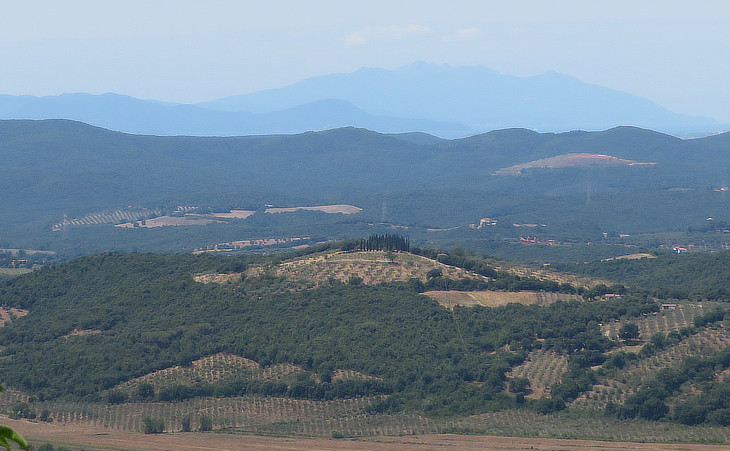
View north-west from the walls of CittÓ Nuova towards the site of ancient Populonia and the Isle of Elba
May 1790. The spiritual government of Elba belongs to the Bishop of Massa, in the Maremma, who is invested with the superintendance of all the benefices. Every district seems to swarm with priests.
Richard Colt Hoare - A classical tour through Italy and Sicily - 1819
Massa became a bishopric see in the XIth century when the Bishop of Populonia, an ancient Etruscan port opposite Elba, relocated there because Populonia was abandoned after having been raided by pirates in the early IXth century. We know that already in the early Vth century the town was in a state of decline:
Against us rises a North wind; but we too strive with oars to rise, while daylight shrouds the stars. Close at hand Populonia opens up her safe coast, where she draws her natural bay well inland. No Pharos, conspicuous with nightly light, has piers built there which rise in order to sky; but men long ago, finding a mighty cliff to serve as a look-out where the towering hill-crest overhangs the conquered waves, laid the foundations of a castle for twin services to man - a defence on land and signal-post for sea. The memorials of an earlier age cannot be recognised; devouring time has wasted its mighty battlements away. Traces only remain now that the walls are lost: under a wide stretch of rubble lie the buried homes. Let us not chafe that human frames dissolve: from precedents we discern that towns can die.
Rutilius Claudius Namatianus - De Reditu Suo (A Voyage Home to Gaul in 415 AD) - Loeb Edition 1934.
The inland location of Massa and its commanding position on a hill provided the Bishops with a more secure location. The diocese of Massa continued to include Elba with its rich iron mines.
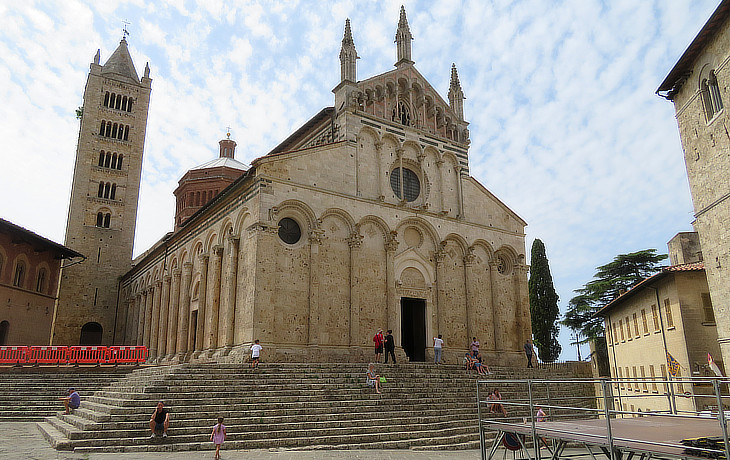
The Duomo is a small, neat edifice, of the thirteenth century, in the Byzantine style, with a low dome and a triple tier of arcades in the fašade.
George Dennis - The Cities and Cemeteries of Etruria - 1848.
Tuscany may be divided into three great centres
of architectural activity. Florence (..), Lucca (..). Pisa, with her innumerable arcaded
galleries, her multicoloured fasciae and rhomb patterns,
finds imitators throughout Italy. The monuments of
Sardinia are Pisan; as well as many churches in other
districts; in the neighbouring Lucchesia, in Pistoja, Volterra and S. Gimignano, and further south in Massa
Marittima. (..) We have endeavoured to reproduce the most beautiful examples in which Romanesque art developed according to its natural elements, in spite of employing
Byzantine or Norman forms of expression, or importing
French and German traits.
Corrado Ricci - Romanesque Architecture in Italy - 1925
Ricci, an Italian archaeologist and art historian, and the President of the Italian Institute of Archaeology and History of Art, included two images of the Cathedral of Massa (one, similar to that above, and a detail of the main portal) in his book. Until then not much attention had been paid to the architectural features of the Cathedral.

Cathedral - details of the fašade: (left) lower part (influence of Pisa - see a detail of its Cathedral - it opens in another window); (right) upper part with pointed arches (influence of Siena - see its Cathedral)
The
"Comacini', who chiefly flourished in the valleys of
the North Italian Lakes, were either handicraftsmen (on
whom the bricklayers and stonemasons - "collegae"' or
"consortes" - were dependent), or they were the celebrated companies of
architects and stonemasons. They boldly
solved the main part of
the constructional problems, and even worked beyond the Alps. Ricci
The construction of the Cathedral began in ca 1228. An inscription on a column inside the building says: HENRICUS HOC OPUS FECIT. The architect is thought to be Enrico, a master stonecutter from Como, a town in Northern Italy which was the home of many medieval architects who are collectively known as Maestri Comacini.
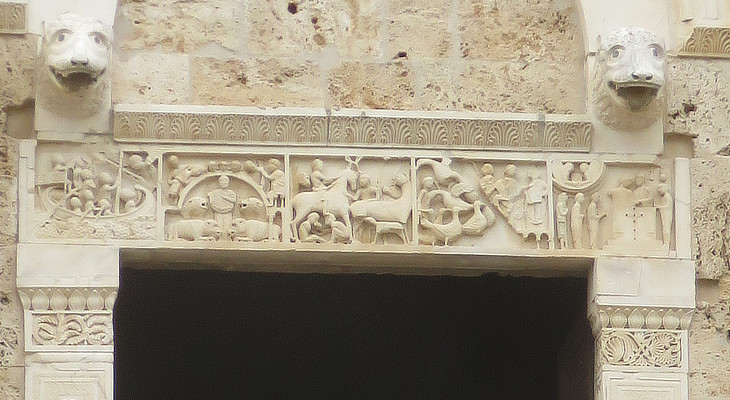
Cathedral: relief of the main portal which depicts events of the life of Saint Cerbone, to whom the Cathedral is dedicated (together with the Virgin Mary); the events are depicted in almost reverse chronological order
According to tradition after the death of Florenzio, Bishop of Populonia, in ca 546, the citizens asked that Cerbone serve as their bishop, but they soon became frustrated with him, because he rose every Sunday at daybreak and said mass instead of doing so at the normal hour. The people complained to Pope Vigilius, who, on hearing what Cerbone had done, became angry and sent legates to Populonia to bring the bishop to Rome. They found Cerbone eating breakfast and accused him of heresy, believing that he was eating before performing mass, when in fact he had already performed the service.
They brought him to Rome. During the way, he domesticated some does to provide the hungry legates with milk (third relief), he cured three men suffering from fever and tamed some wild geese by making the sign of the cross over them, which explains this particular attribute. The geese accompanied him to St. Peter's and flew off after Cerbone made the sign of the cross over them again (fourth relief).
At Rome, the next morning at daybreak, Cerbone went into the Pope's chamber and roused him out of bed. He then asked the Pope if he did not hear angels singing; Vigilius replied that he did hear something of the kind (fifth relief). Cerbone went off to say mass and Vigilius gave him leave to say his mass at any hour of the morning that pleased him, and sent him back to Piombino.
For hiding several Roman soldiers, he was ordered to be killed by wild bears by Totila, king of the Ostrogoths. The bears remained petrified before Cerbone (second relief). They fell back on their paws and licked his feet. Totila exiled Cerbone to Elba.
Around 575 AD, Cerbone begged to be buried in Populonia. The ship carrying his body ran into a heavy storm, but arrived safely at Populonia (first relief).
The image used as background for this page shows a marble inlay of the main altar depicting some geese.

Cathedral: upper part of the southern side with a green marble decoration
The religious monuments of Florence, e.g. S. Maria Novella, are often characterized by the use of "Green of Prato", a serpentinite stone having different shades of green from light to dark and even black, from the quarries of Monte Ferrato, near Prato, a town near Florence. Its use at Massa indicates the influence of the monuments of Florence over the whole region and the wealthiness of Massa which could afford to buy this stone. The decoration with bands of a dark colour dividing a surface of white into compartments originates from opus listatum, a Roman construction technique which became a decorative pattern in Byzantine and Islamic art.
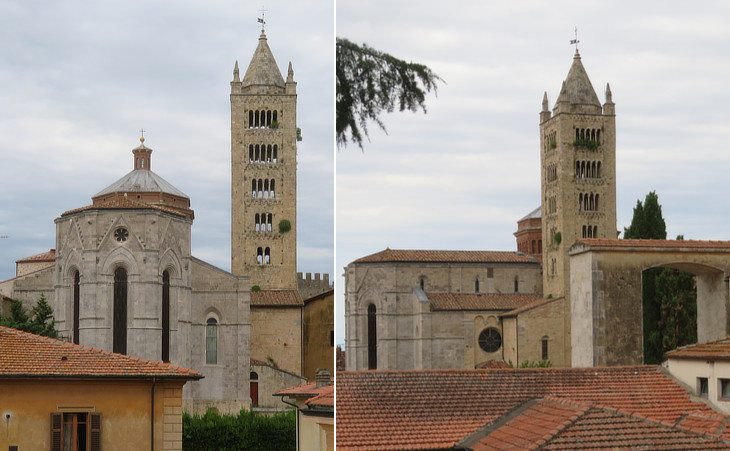
The Cathedral was built on uneven ground and the original plan did not foresee such a long building. The project was modified at the end of the XIIIth century and the apse stands upon artificial substructions, which make its view very imposing. The bell tower was partly redesigned in the XXth century and it is now very similar to that of the Cathedral of Siena.
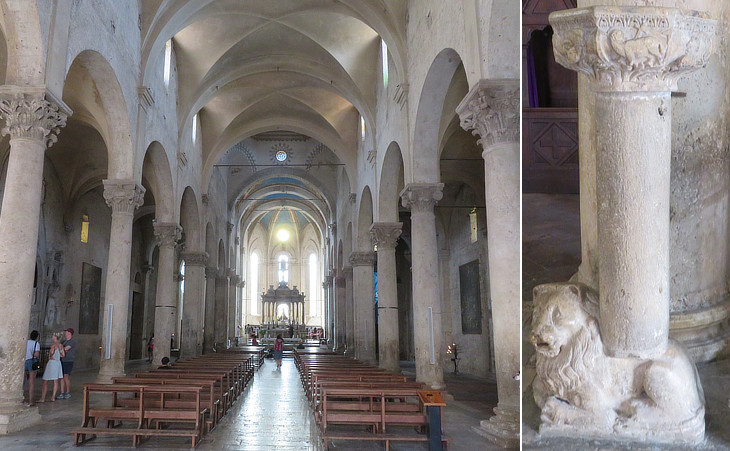
(left) Interior; (right) holy water font (end of the XIIIth century)
The interior is not in keeping, being spoilt by modern additions, and has nothing of interest beyond a very curious font of early date, formed of a single block. Dennis
The additions mentioned by Dennis have been almost entirely removed to give the interior its original appearance and highlight the depth of the three naves. The columns are of slightly different height and their plinths and capitals are adjusted to provide an appropriate support to the arches.
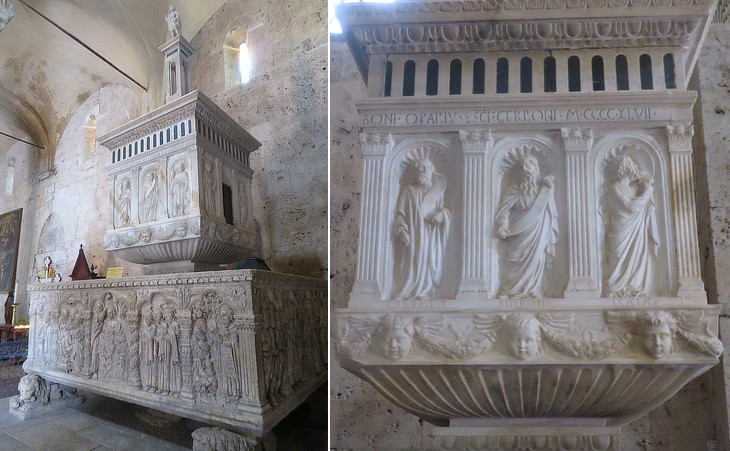
(left) Baptismal Font; (right) its Renaissance addition with portraits of Jeremiah, Simeon and Isaiah
The lower part of the baptismal font is a large rectangular basin which was made in 1267 by Jacopo, a sculptor from Como, out of a single block of travertine. This stone, typical of Rome, was quarried near Siena. The size of the basin allowed for a baptism of adults by immersion. In 1447 a marble tabernacle was erected at its centre. Its fine reliefs portray Prophets and Patriarchs, but its overall design does not match that of the lower part.
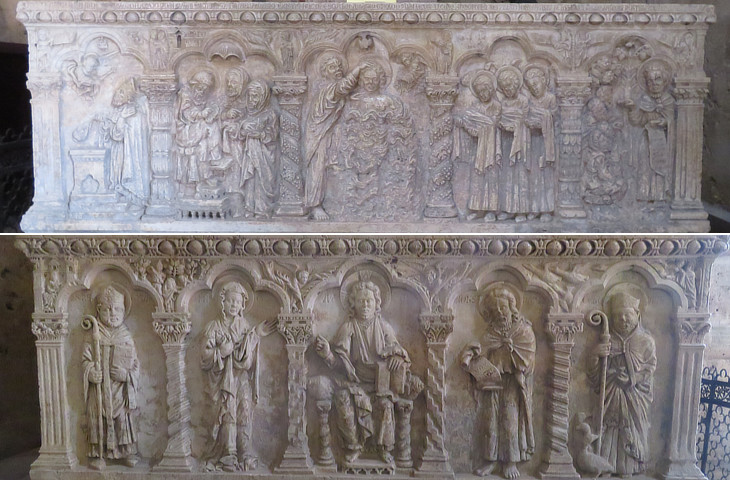
Baptismal Font: the two long sides: (above - left to right) Zechariah is announced by an angel that his wife would give birth to a son; Zechariah writes the name of his son; Baptism of Jesus; angels prepare the swadding clothes; St. John the Baptist preaching; (below) St. Regolo, a bishop who taught to Cerbone; Mary; Jesus in throne (based on a Byzantine iconography); St. John the Baptist; St. Cerbone and the geese
The placing of the reliefs inside niches is based on a pattern which was developed in the IInd century AD, mainly for sarcophagi depicting the Twelve Labours of Hercules, see an example in Rome.
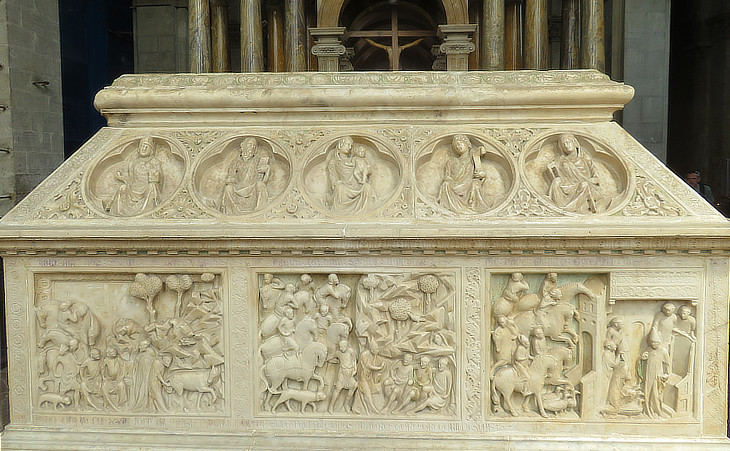
Arca (sarcophagus) of St. Cerbone
The rapid development of Italian sculpture is testified to by another sarcophagus-type monument which was made in 1324 by Goro di Gregorio, a sculptor from Siena. The personages portrayed inside four lobe frames (a reference to the Cross) are saints, prophets, the Virgin Mary and St. Cerbone. The rectangular reliefs depict episodes of the life of St. Cerbone, some of which are already portrayed on the main portal, but in a more elaborate manner.

Arca (sarcophagus) of St. Cerbone - short sides: (left) the papal envoys tell Bishop Cerbone that he is summoned by the Pope; (right) St. Cerbone and the Pope celebrate Mass
The body of St. Cerbone was actually moved to Massa in 1600. A 1588 inscription advised the faithful that for their visit to the Cathedral they were granted 40 days of indulgence. The town however was already in a state of great economic decline and few pilgrims visited it as they avoided the unhealthy route along the sea and reached Rome via Siena and Viterbo.
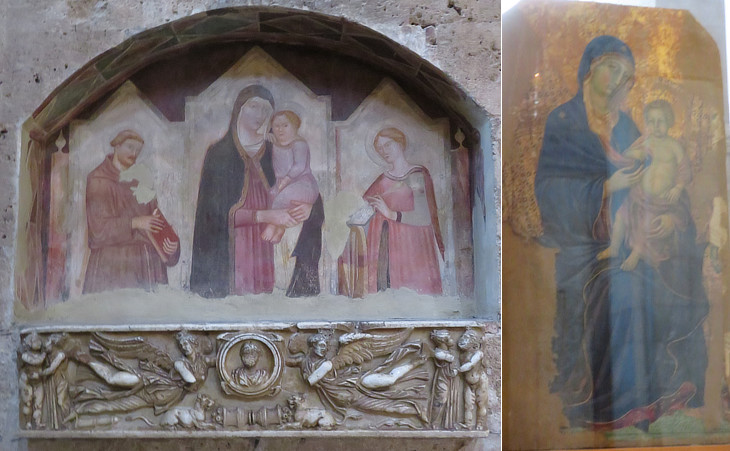
(left) A fresco portraying a Madonna between St. Francis and St. Catherine of the Wheel (XIVth century) above a Roman sarcophagus; (right) a Madonna attributed to Duccio da Boninsegna, a major painter of Siena
The walls of the interior were decorated with frescoes by painters of Siena, but only some fragments of them are still visible. The sarcophagus is decorated with a portrait of the dead between winged Victories and couples of Cupid and Psyche (see a similar one at Palazzo Corsini).
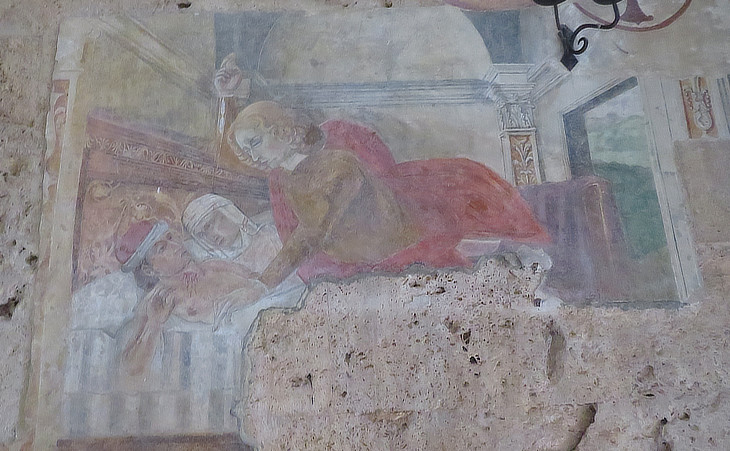
Fragment of a fresco portraying St. Julian killing his parents by mistake, which is interesting because it provides an insight into the ordinary life of XIVth century wealthy citizens
He climbed the three terraces and opened the door with a blow of
his fist; but at the foot of the staircase, the memory of his
beloved wife softened his heart. No doubt she was asleep, and he
would go up and surprise her. Having removed his sandals, he
unlocked the door softly and entered.
The stained windows dimmed the pale light of dawn. Julian stumbled
over some garment's lying on the floor and a little further on, he
knocked against a table covered with dishes. "She must have
eaten," he thought; so he advanced cautiously towards the bed
which was concealed by the darkness in the back of the room. When
he reached the edge, he leaned over the pillow where the two heads
were resting close together and stooped to kiss his wife. His
mouth encountered a man's beard.
He fell back, thinking he had become crazed; then he approached
the bed again and his searching fingers discovered some hair which
seemed to be very long. In order to convince himself that he was
mistaken, he once more passed his hand slowly over the pillow. But
this time he was sure that it was a beard and that a man was
there! a man lying beside his wife! Flying into an ungovernable passion, he sprang upon them with his
drawn dagger, foaming, stamping and howling like a wild beast.
After a while he stopped.
The corpses, pierced through the heart, had not even moved. (..) His father and mother lay before him, stretched on their backs,
with gaping wounds in their breasts; and their faces, the
expression of which was full of tender dignity, seemed to hide
what might be an eternal secret.
Gustave Flaubert - The Legend of Saint-Julian the Hospitaller - 1877
St. Julian was born in the Flanders and he joined the Order of the Hospitallers (eventually the Knights of Malta). He is usually portrayed as a knight (see S. Giuliano dei Fiamminghi in Rome and the church dedicated to him at Erice in Sicily).
Return to The Town.
In Maremma - other pages:
Corneto (Tarquinia)
Corneto (Tarquinia) - Palazzo Vitelleschi and Museo Archeologico Nazionale di Tarquinia
Tarquinia - Etruscan Necropolis of Monterozzi
Montalto di Castro and Canino
An Excursion to Orbetello
An Excursion to Porto Ercole
An Excursion to Grosseto
An Excursion to Volterra

